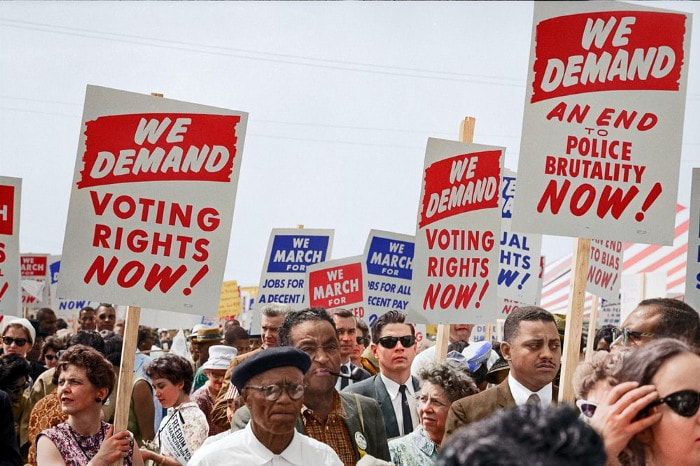|
By Star Zagofsky I recently watched Whose Vote Counts, Explained, a 3-episode Netflix series about voting that should be required viewing for anyone interested in racial justice. The first episode, “The Right to Vote,” starts things off with a long list of eye-opening facts like how, until the mid 1800s, it was common for non-citizens to vote in US elections. As it turns out, many voting restrictions that seem normal in the US are, in fact, not. Today more than 45 countries permit non-citizens to vote, and in 35 countries either all or most people convicted of felonies can vote, even while in prison. So why is the US different? Whose Vote Counts, Explained outlines the history of US voting as well as the myriad constitutional amendments that have been enacted to fix the problems created by our country’s founders. If you read The U.S Constitution — which, of course, who doesn’t? — you won’t find voting rights mentioned in the original text or the Bill of Rights. In fact, you won’t find voting rights mentioned at all, in any form, until the 14th and 15th Amendments. Surprised? Me too. Enacted to solidify the rights of Black Americans after the Civil War, the 14th & 15th Amendments state that the rights of citizens to vote shall not be denied or restricted on account of race, color, or previous condition of servitude. Note the specific language there — the right to vote could not be restricted for the following reasons. The amendments clearly left open the possibility of voting restrictions, just so long as they weren’t based on race. The voting amendments that followed — including the 19th Amendment, which gave women the right to vote and the 26th Amendment, which reduced the voting age to 18 — used similar language and only banned laws that restricted voting for specific reasons, like on the basis of sex or age, but none ever went so far as to ban voting restrictions entirely. Laws that restrict voting rights are not innocent The list of disenfranchisement laws is long, and it includes a lot of requirements and restrictions that may sound reasonable, until you dig deeper. For one example, limiting the rights of people convicted of felonies was — and still is — billed as a reasonable measure because, according to the Heritage Foundation, “If you’re not willing to follow the law, then you should not have a role in making the law.” Which sounds reasonable, right? Wrong. In practice our system of criminal justice, with its restrictions on voting rights, has never been applied equally. Starting in the late 1860s after the Civil War ended, Black Americans were imprisoned and convicted of felonies for extremely minor offenses such as walking along the railroad tracks or even non-crimes like not having a job. These unjust laws, also known as “Black Codes,” led to mass imprisonment of Black citizens, restricting their ability to vote. (Once imprisoned, Black Americans were also forced to work for no pay, essentially re-enslaving them, which you can read more about in books like Slavery by Another Name.) Another example of a seemingly reasonable requirement is the literacy test. Until they were banned by the Voting Rights Act in 1965, literacy tests were designed to ensure that only sufficiently educated people would vote. Again, it probably sounded reasonable to restrict voting to people who could read, lest they vote for the wrong person, but in practice the literacy tests were impossible to pass with questions like, “How high is up?” and “How many bubbles are in a bar of soap?” By 1940, as a result of all of these “reasonable” voting restrictions, only 3% of African Americans were registered to vote. That’s right — 3%. For a short while, things were different After the nation was shocked by the sight of peaceful protestors being attacked, maimed and even murdered by those in power, the Voting Rights Act passed in 1965 and the right to vote was restored — not just in theory, but now in practice — to 90% of American citizens. Finally we were close to being the true democracy (or democratic republic, if you want to get technical) that we had claimed to be for over 150 years. Then, in 2013, things changed. The Supreme Court gutted the Voting Rights Act, which ushered in a new era of voting restrictions, including closing polling places and requiring ID to vote in order to, as proponents argue, “prevent voter fraud.” (Voter fraud, incidentally, has been used to justify voter suppression since the early 1800s. Nevermind that the data show such fraud is extremely rare.) Lawmakers have since attempted to pass new legislation to restore provisions of the Voting Rights Act, but their efforts have been blocked. Consequently, today in the US Black voters face significantly more obstacles to cast a ballot compared to White voters. Black voters, on average, wait in line 45% longer than White voters, and they’re also more likely to be purged from voter rolls, making it more difficult for them to vote at all. Where we go from here & how to act If, like me, you believe that everyone should be allowed to vote — period, then here are some actions you can take: Short term:
Medium term:
* Any facts without a source are attributed to Whose Vote Counts, Explained. Comments are closed.
|
Find articles
All
Browse by date
July 2024
MEDIUM |
© COPYRIGHT 2017-2024 SURJ BAY AREA. ALL RIGHTS RESERVED.



 RSS Feed
RSS Feed